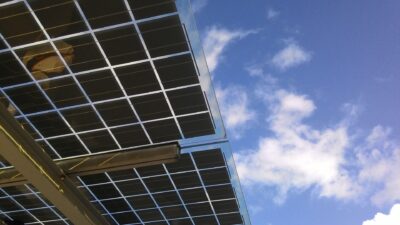The Current Problem with Solar Power
The Sun is Earth's greatest power source. The amount of solar energy that hits the Earth's surface in just two hours is enough to meet the current energy demand of the whole world for an entire year. Sunlight is a free and abundant natural resource that allows us to produce energy in an environmentally safe and sustainable manner. While we have become adept at harnessing the Sun's rays and converting them into usable energy, the current problem is that the Sun does not always shine. A critical task for solar energy is finding adequate ways to store it for future use.
What Is Solar Power?
Solar energy refers to the radiant energy and heat emitted by the Sun. Solar power generation is the conversion of solar energy into a usable form of power. Solar power is considered a clean, sustainable power source because it relies on harvesting energy from naturally occurring sunlight through an emissionless process. In addition, it is considered a renewable energy source since sunlight is abundantly available and producing solar energy does not deplete natural resources.

Solar energy is captured through the use of photovoltaic (PV) panels. The photons of light from the Sun excite silicon cells in the panels and produce electricity through the photovoltaic effect. Electricity produced through the photovoltaic effect is a direct current (DC), so a solar inverter is required to convert the DC electricity to alternating current (AC) electricity. This electricity is available for immediate use by homes and businesses or to supply the power grid. Ideally, these panels are positioned in an area that maximizes sunlight such as an open area without shade or on the rooftop of the building. Shade of any kind presents a significant problem and results in a corresponding decrease in energy production. Some solar panels tilt to face the sun so they can collect more energy. Tilting of the panels is achieved and controlled with a solar tracking system.
Solar energy is attractive to home and business owners for a variety of financial and environmental reasons. The cost savings that are possible in monthly utility bills are substantial and over time the costly systems will pay for themselves. The development of clean, green energy sources promotes job growth and mitigates pollution from increased energy production. Investing in solar energy today also prevents utility companies from having to expand expensive fossil fuel plants to meet future energy demands.
How Is Solar Energy Currently Stored?
 As solar energy is harnessed it is either used immediately as electricity or stored for later use. One of the problems with solar energy is that these current methods of storage are inadequate for future needs. According to Michael Aziz, a professor of energy technologies at Harvard University, storing massive amounts of electrical energy during the optimal periods is the “single biggest obstacle to getting a large fraction of our electricity from solar power.” Scientists will need to expand on these ideas or develop new storage capabilities in order to expand the percentage of global electricity that is produced from solar energy.
As solar energy is harnessed it is either used immediately as electricity or stored for later use. One of the problems with solar energy is that these current methods of storage are inadequate for future needs. According to Michael Aziz, a professor of energy technologies at Harvard University, storing massive amounts of electrical energy during the optimal periods is the “single biggest obstacle to getting a large fraction of our electricity from solar power.” Scientists will need to expand on these ideas or develop new storage capabilities in order to expand the percentage of global electricity that is produced from solar energy.
Current storage methods rely on batteries, thermal storage, pumped-storage hydroelectricity, compressed air, flywheels and the production of fuels for later use:
- Batteries: During the day, as solar panels produce excess electricity, this energy is used to charge batteries that store the energy for later use. Large lithium ion batteries are often used. Engineers are working on a new technology that would store solar power using inexpensive, organic fuels.
- Supercapacitors: These structures store large amounts of electricity in an electric field.
- Molten Salt: The thermal energy produced from sunlight is stored in an ionic compound like that of molten sodium chloride. Later, when electricity is called for, heat from the molten salt is transferred to water to produce steam and drive a more traditional turbine.
- Pumped-Storage Hydroelectricity: This method stores energy in the form of gravitational potential energy. When excess energy is being produced, that energy is used to pump water from the bottom of a hydroelectric dam to the top of the reservoir. In order to recapture the stored energy, water is released at the base of the dam to power a hydroelectric generator, which converts energy extracted from the moving fluid into electricity.
- Compressed Air: These systems store excess energy as compressed air. When required, the compressed air is released, spinning a turbine-generator, producing electricity.
- Flywheels: In some applications, excess energy is used to spin a flywheel, creating rotational energy. Energy is extracted from the system by reducing the flywheel’s speed.
- Producing Fuel: Rather than convert solar energy to electricity immediately, this method relies on using the immediately available energy to produce a fuel for later energy consumption. For example, a petrochemical cell uses solar energy to split water into hydrogen and oxygen atoms which are stored as fuels. The gasses are later recombined in a fuel cell that produces electricity.
Current Problems with Solar Energy
One serious drawback to solar energy is its intermittent availability. During optimally sunny conditions, energy production is high, but as the Sun sets and darkness falls, production falls to zero. The question remains, how do we best store the energy we produce during the day for use later on cloudy days or overnight? Some current methods of storage have drawbacks. They use costly materials, provide inadequate storage, have low power densities, or involve overly complicated processes to produce electricity. While solar energy offers a long-term sustainable energy source, it is not without problems in its current state.
 " alt="">
" alt="">